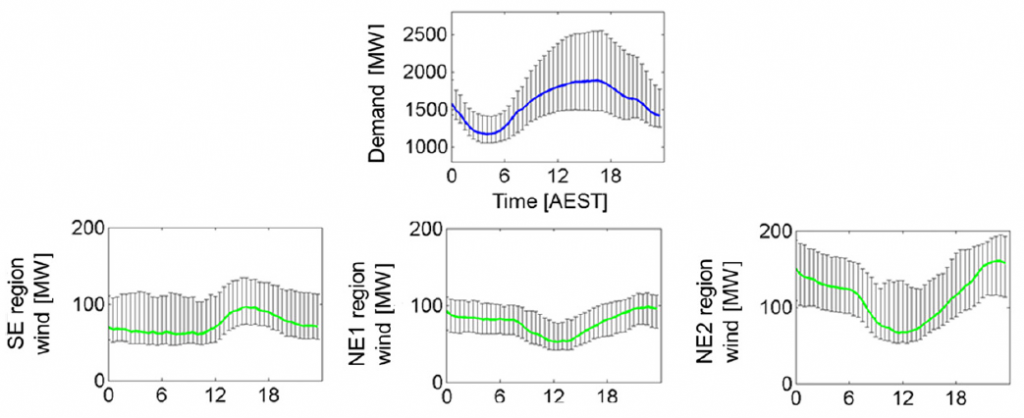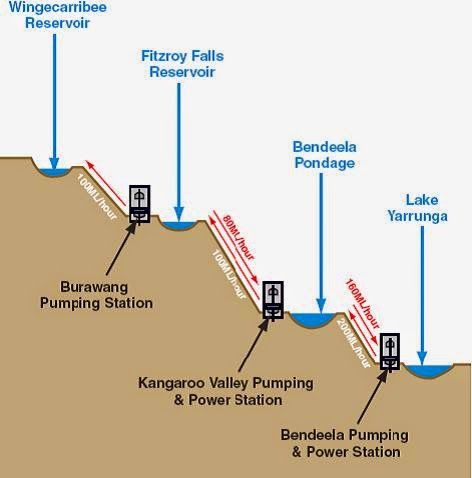Widespread implementation of pumped-hydro is the only simple fix for global warming. It will radically cut CO2 emissions without putting up the price of electricity.
Updated 24 February 2017
Energy Storage is needed in Australia
Pumped-Hydro provides a means to store “electricity energy” that is not immediately required. It does this by using this energy to pump water uphill. Later, when this energy is actually required by the users on the electricity grid, it can be quickly converted back into electricity by allowing the water to run down the pipes used to pump it uphill, thereby turning the generators at the bottom of the hill (being the same “devices” used to pump the water uphill in the earlier stage). The losses from this “storage process” are minimal, and actually have a very low cost. Most of the costs arising from this process relate to the need to build water storage, pipes and electricity generators (which also serve as the pumps).
In Australia, there is a great need to be able to store this surplus generated electricity, since electricity generation from wind does not match the demand pattern. This is beautifully illustrated by this set of graphs from a study of Wind generation in South Australia.

Here the demand is shown in the top graph, and supply from wind is shown in the bottom three graph, broken up into three regions of South Australia. As can be seen here, the largest generation region actually generates most electricity during the off-peak period from 2200 to 0600. At present, this large imbalance has had a very bad effect – it has led to the Alinta generators at Pt Augusta being shut down, since they could no longer be run 24 hours a day. They couldn’t compete with electricity supplied at a negative cost from these wind farms – a distortion created by a dysfunctional renewable energy certificate scheme. A better fix would be to utilize the storage capability of pumped hydro.
Why Pumped-Hydro?
Electricity is generated from wind energy for 24 hours a day: the quantum dispatched depends upon the wind and not upon electricity demand. Electricity generated during times of low demand is effectively squandered unless it is stored. The primary storage mechanism currently available is hydro-pumped storage, which is the central plank (with wind power) for Portugal achieving over 50% renewable energy. It is also used in Denmark, where existing hydro facilities in Norway and Sweden are used to recycle otherwise wasted wind-power electricity.
In Australia, pumped hydro could be implemented in NSW at the Fitzroy Fall Reservoir. This is a part of the water storage facility on the Shoalhaven River. At present it is mostly used to condition electricity generated by wind farms. Something more is required.
It is easily understood that electricity is generated by wind at times when it is not needed, this being an issue especially during the night. On the other hand, wind generators have no capacity to increase output during times of peak demand. Indeed, the extra electricity generated during these off-peak times adds to significant inefficiencies in the total supply system, with other generators having to be shut down to accommodate the additional power being produced from wind. This has happened in South Australia, where the Pt August brown coal generators became uneconomic, simply because they couldn’t be run for 24 hours a day, as they were originally designed to do.
The conventional solution to this “over-supply problem” is to store the electricity generated during the off-peak times using pumped-hydro. For example, Denmark do this with their wind energy, selling it to Norway and Sweden, who store it in their hydro systems, using this system “as a battery,” by pumping water uphill, and then releasing it later. These countries then sell the electricity back into the European grid at a higher cost than they bought it, thus providing themselves with a nice little earner.
Funding Pumped-Hydro
Using pumped-hydro power in this way can be easily accommodated as part of a wider hydro-electric scheme, such as in Norway, Sweden, and in the Australian Snowy Mountains and at Fitzroy Falls. The question remains whether a pumped-hydro electric scheme can be developed that has its sole justification in this kind of storage and release arrangement.
The economics of such a proposal is quite simple:
- Electricity is purchased at $A25 MWh at off-peak times. Even with a 25% efficiency loss, this would only equate to $A31 MWh.
- Electricity could be sold at $A275 MWh at peak times.
- The electricity dispatch could be run for 6 hours every weekday, for 52 weeks a year.
- Since the pumping operation could be run for 9 hours every day, also for 52 weeks a year this means that the system could also supply Shoulder tariff electricity (at $A160 MWh)
- Cash flow from direct operating costs would be $A244 per MWh for peak electricity sold, and $A129 MWh for Shoulder tariff electricity sold.
- If it were to run for one year, 6 hours per day, 52 weeks a year, 5 days a week, 90% of the time, it would return a cash flow of up to $A340,000 per year per MW installed, just for peak-load supply.
- If it were to run for one year, 12 hours a week, supply Shoulder tariff electricity, it would return an extra cash flow of $A80,000 per year per MW installed.
- Total direct cash flow would be $A420,000 per MW installed.
- Installed costs for Hydro have been costed at between $US1m MW to $US7m MW (= $A1.4m and $A10m)
- Operating costs could be managed to be around 2.5% of installed cost.
- Allowing for operating costs of 2.5%, and a 10 year payback period, it will be economic to install such a facility, provided the cost of such an installation worked out to be up to $A3.5m per MW.
Thus, with proper planning is should be possible to deliver a profitable operation, without actually increasing the cost of electricity as delivered. One should also be able to see the potential to actually reduce the cost of delivered electricity, once sufficient pumped-hydro facilities have been build and commissioned, especially if they began their life as government funded facilities.
Pumped-hydro is a viable option in Australia
For those interested in following up this issue, I draw your attention to a December 2016 Engineers Australia article (p.46-53) which reported that Professor Andrew Blakers, ANU, observed that pumped-hydro has a cost impact that is a fraction of battery backups.
Blakers is reported to say that, in order to be cost competitive, the system should have modern high-quality turbines, 10 MW or greater, with the “top dam” being 400-900m above the “bottom dam”. They should also be “off-river.” He also commented that such facilities would not be difficult to site.
While Australian government funded ARENA seem to be happy to fund projects, such as the Kidson solar + pumped-hydro, there seems to be some problem with wind + pumped-hydro. This points to a fundamental problem with ARENA and other government funding and private advocacy organizations. For them, it seems that it must be solar, nuclear, or nothing. To hell with cost. Surely this cannot continue. Contact your MP and demand that action be taken that will reduce the cost of electricity, not just funding “lovely to have” projects, as seems to be the case at the moment.
Actually, the best option for increased pumped hydro is via the Snowy Mountain scheme, where it is likely that Tumut 3 power station could be upgraded to handle all the surplus electricity generated from wind farms throughout the National Electricity Market.
Useless arguments
Those who think that they know something about this subject are obsessed with establishing a carbon price, via some mechanism. My question for them is, “What will that do to resolve the problems caused by the over-supply of wind-powered electricity in South Australia?” The answer is obvious. “It will do nothing!”
The other “useless argument” is put forward by nuclear energy advocates. They don’t want anything to dampen their advocacy for that lost cause. Unable to really respond constructively to the risks indicated by the failures at Chernobyl and Fukushima, they attack pumped hydro as an improbable solution to the problem of a lack of consistent supply of electricity with non-arguments. We can forget about them until they can properly address voters’ legitimate concern about uranium nuclear.
More serious is the fact that the installation of a new 500 MW pumped hydro system in Germany because there is insufficient “surplus electricity” in that country. So it is the case, although they were prepared to go ahead with their plans when the ratio between average peak demand and average demand was 1.2 to 1.0. They delayed their plans when the ratio dropped to 1.1 to 1.0, which has been attributed to solar PV, which has taken the edge off peak demand, even though it remains a relatively minor contributor to total electricity supply. However, in South Australia the ratio between average peak demand and average demand is 1.4 to 1.0. If Australia were Germany, the extra capacity would be installed immediately.
It is time we left behind the dead arguments of 2007, and examined propositions more appropriate for 2017 and beyond.
Anyone who is concerned about global warming and climate change could surely not vote for a party that advocates an out-of-date, and ineffective, solution to the problem of too much CO2 in the atmosphere. Here the most vigorous advocates of action on this subject need to look carefully at their own motivation, for surely others will do the same.


You actually ensure it is sound so simple with your display on the other hand obtain this disorder to get truly some thing which I am I might by no means recognize. This variety of thinks as well complicated and really considerable in my opinion.. electricity 1 I am taking a look toward your own next post, I’ll attempt to have the grasp of the usb ports!
The voice of raiyonalitt! Good to hear from you.
Speaking to the problems associated with energy production more broadly, and assuming alternative source choices between wind, sun, geo-thermal, etc. can be hashed out based on local economics and appropriate siting considerations, a problem still exists when it comes to line losses for transmission of power over distances. Thus, replication of production technology via scaling becomes critical, in order to draw generation source versus end-user consumption in closer proximity.